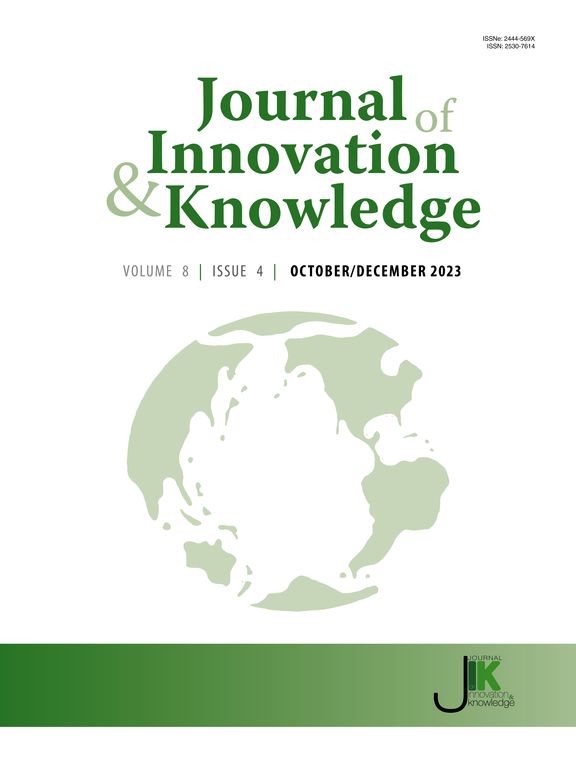National innovation beyond linear models: An exploratory QCA of asymmetric pathways to successful and failure-bound innovation strategies of EU economies post-Covid-19
IF 15.5
1区 管理学
Q1 BUSINESS
引用次数: 0
Abstract
This study examines the asymmetric pathways leading to different innovation performance outcomes in the 27 European Union (EU) member states in the years before and after Covid-19. The study offers a novel approach to innovation analysis that contrasts with traditional linear approaches. Crisp-set qualitative comparative analysis (csQCA) was used to analyze variations in innovation performance pre-Covid-19 (2019) and post-Covid-19 (2023) across the 27 EU member states. Data were sourced from the Global Innovation Index (GII), published annually by the World Intellectual Property Organization (WIPO). The analysis focused on five key dimensions: human capital and research, infrastructure, market sophistication, business sophistication, and gross domestic product (GDP). The results reveal configurations (strategies) of these conditions (dimensions) that lead to successful or failed innovation performance. Four strategies lead to success and three lead to failure, with perfect consistency (1.0) observed across all solutions. A key finding is that the decline of market sophistication is a necessary condition for failure. The study also reveals several complex causal relationships, in which similar conditions can produce opposite outcomes depending on their configurational context. The findings contribute to the innovation policy literature by highlighting the importance of developmental approaches to innovation and by challenging the assumption that singular improvements in firm sophistication necessarily lead to higher innovation performance. Moreover, the research provides interesting insights for policymakers and practitioners, particularly in the context of the new EU Competitiveness Compass and the emerging environmental, social, and governance (ESG) regulatory framework. The study offers evidence-based recommendations for designing resilient innovation strategies in post-crisis scenarios.
超越线性模型的国家创新:后新冠肺炎时代欧盟经济体成功与失败创新战略不对称路径的探索性质量分析
本研究考察了在2019冠状病毒病(Covid-19)前后的几年中,欧盟27个成员国导致不同创新绩效结果的不对称途径。该研究为创新分析提供了一种新的方法,与传统的线性方法形成对比。采用Crisp-set定性比较分析(csQCA)分析了27个欧盟成员国在2019冠状病毒病前(2019年)和2019冠状病毒病后(2023年)创新绩效的变化。数据来源于世界知识产权组织(WIPO)每年发布的全球创新指数(GII)。该分析集中在五个关键方面:人力资本和研究、基础设施、市场成熟度、商业成熟度和国内生产总值(GDP)。结果揭示了导致创新绩效成功或失败的这些条件(维度)的配置(策略)。四种策略导致成功,三种导致失败,在所有解决方案中观察到完美的一致性(1.0)。一个重要的发现是,市场成熟度的下降是失败的必要条件。该研究还揭示了一些复杂的因果关系,在这些因果关系中,相似的条件可能会产生相反的结果,这取决于它们的配置环境。这些发现通过强调发展方法对创新的重要性,以及通过挑战企业复杂性的单一改进必然导致更高创新绩效的假设,为创新政策文献做出了贡献。此外,该研究为政策制定者和实践者提供了有趣的见解,特别是在新的欧盟竞争力指南和新兴的环境,社会和治理(ESG)监管框架的背景下。该研究为在后危机情景下设计弹性创新战略提供了基于证据的建议。
本文章由计算机程序翻译,如有差异,请以英文原文为准。
求助全文
约1分钟内获得全文
求助全文
来源期刊

Journal of Innovation & Knowledge
Multiple-
CiteScore
16.10
自引率
12.70%
发文量
118
审稿时长
37 days
期刊介绍:
The Journal of Innovation and Knowledge (JIK) explores how innovation drives knowledge creation and vice versa, emphasizing that not all innovation leads to knowledge, but enduring innovation across diverse fields fosters theory and knowledge. JIK invites papers on innovations enhancing or generating knowledge, covering innovation processes, structures, outcomes, and behaviors at various levels. Articles in JIK examine knowledge-related changes promoting innovation for societal best practices.
JIK serves as a platform for high-quality studies undergoing double-blind peer review, ensuring global dissemination to scholars, practitioners, and policymakers who recognize innovation and knowledge as economic drivers. It publishes theoretical articles, empirical studies, case studies, reviews, and other content, addressing current trends and emerging topics in innovation and knowledge. The journal welcomes suggestions for special issues and encourages articles to showcase contextual differences and lessons for a broad audience.
In essence, JIK is an interdisciplinary journal dedicated to advancing theoretical and practical innovations and knowledge across multiple fields, including Economics, Business and Management, Engineering, Science, and Education.
 求助内容:
求助内容: 应助结果提醒方式:
应助结果提醒方式:


